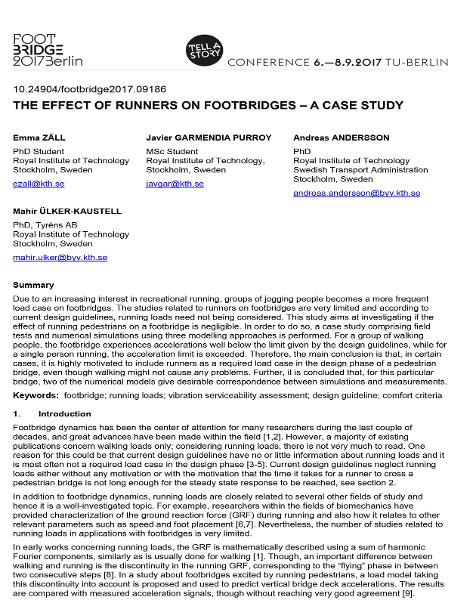The Effect of Runners on Footbridges - A Case Study

| Author(s): |
Emma Zäll
Javier Garmendia Purroy Andreas Andersson Mahir Ülker-Kaustell |
|---|---|
| Medium: | conference paper |
| Language(s): | English |
| Conference: | Footbridge 2017 Berlin - Tell A Story, 6-8.9.2017, Technische Universität Berlin (TU Berlin) |
| Published in: | Footbridge 2017 Berlin - Tell A Story |
| Year: | 2017 |
| DOI: | 10.24904/footbridge2017.09186 |
| Abstract: |
Due to an increasing interest in recreational running, groups of jogging people becomes a more frequent load case on footbridges. The studies related to runners on footbridges are very limited and according to current design guidelines, running loads can be neglected. This study aims at investigating if the effect of running pedestrians on a footbridge is negligible. In order to do so, a case study comprising field tests and numerical simulations using three modelling approaches is performed. For a group of walking people, the footbridge experiences accelerations well below the limit given by the design guidelines, while for a single person running, the acceleration limit is exceeded. Therefore, the main conclusion is that, in certain cases, it is highly motivated to include runners as a required load case in the design phase of a pedestrian bridge, even though walking might not cause any problems. Furthermore, it is concluded that, for this particular bridge, two of the numerical models give desirable correspondence between simulations and measurements. |
| Keywords: |
footbridge comfort criteria running loads vibration serviceability assessment design guideline
|
| License: | This creative work is copyrighted. The copyright holder(s) do(es) not grant any usage rights other than viewing and downloading the work for personal use. Further copying or publication requires the permission of the copyright holder(s). |
Structure Types
0.85 MB Download full text file (PDF)
0.31 MB
- About this
data sheet - Reference-ID
10075231 - Published on:
01/09/2017 - Last updated on:
02/06/2021




